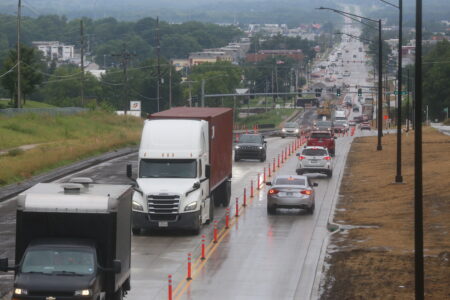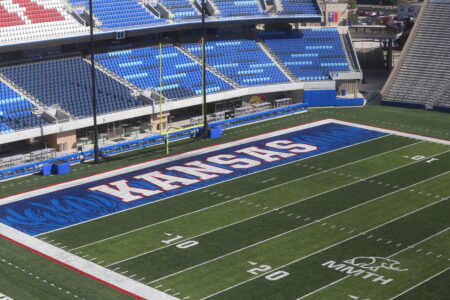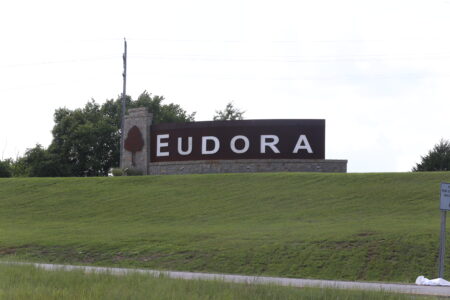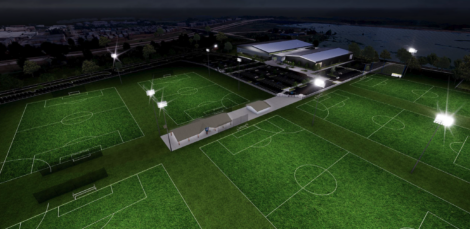
Wichita State study predicts Lawrence will be the fastest growing city in Kansas over next 50 years
But study's author says housing shortages could derail projections
Lawrence is poised to grow over the next 50 years. In fact, a new report from Wichita State University says Lawrence has the ingredients to be the fastest growing community in the state between now and 2072.
Whether it will have the housing is another matter.
Lawrence landed atop the list of fastest growing communities in Kansas when WSU economists recently compiled their statewide population projection report. But the report’s lead economist did acknowledge to the Journal-World that the population projections don’t do much to consider housing availability in a community, and how that will impact population growth.
Rather, the report looks at broader demographic factors, which should lead to growth in a community. The report found Lawrence is one of the few communities in the state that has demographic factors that are predisposed to growth, but that doesn’t mean the city actually will see it.
“It is a barometer for communities of what they might be expecting,” Jonathan Norris, WSU research economist, said of the population projections. “It very well may fall short or exceed the projections based on policy decisions and investments the community makes. Building housing stock is certainly a major investment for a community.”
For the moment, let’s assume Lawrence will have the housing. What does WSU expect for the Lawrence metro — which is Douglas County — and other metropolitan and micropolitan areas in the state? Here’s a look the projected 2072 population for each community and its 50-year growth rate.
• Lawrence: 176,128, up 46.8%
• Kansas City: 1,222,272, up 33.9%
• Manhattan: 167,920, up 26.1%
• Wichita: 793,443, up 22.0%
• Topeka: 225,256, down 2.8%
• Salina: 65,639, up 10.5%
• Hutchinson: 66,184, up 7.5%
• Rural Kansas: 309,602, down 18.4%
At 46.8%, Lawrence’s growth rate is the largest of any metro or micropolitan area in the state. The number looks big at a glance, but remember, it is over 50 years. It averages out to a growth rate of 0.93%. Douglas County grew by about 1% per year during the decade of the 2000s. During the 1990s, the growth rate was about 2.2% per year. It has only been since 2010 that growth has slowed well below 1% per year. The decade of the 2010s produced growth of about 0.7% per year.
Whether the WSU projections will be close to reality is unknown. There have been plenty of population projections for Lawrence that haven’t panned out over the years. Factors that WSU says Lawrence has going for it are a young population, a more dynamic commercial business scene than most cities in the state, and positive migration trends.
But the question remains: Will Lawrence have enough housing to be the state’s fastest growing community? Norris doesn’t have an answer, nor do I. But the WSU report does provide a number for local leaders to circle: 500 new homes per year.
The math behind that number is relatively simple. The WSU study predicts Lawrence will add 56,164 residents over the next 50 years. The Census Bureau says the average household size in Lawrence is 2.23 people per house. (I think I was the 0.23 of a person in my household Thursday morning, as I stumbled through the darkness, wondering why every lightbulb in the house was out.)
Based on that average, Lawrence would need 25,185 new homes over the next 50 years to house everybody (and that is assuming that we don’t tear down any homes, which isn’t realistic.) Divide that 50-year total by 50 and you come up with 503 homes per year.
Is Lawrence building 500 new homes per year? First, define home. It could be an apartment, a duplex or a single-family home. Lately, Lawrence has not built 500 new homes a year even when you add all those categories together.
Using city of Lawrence building permit data, Lawrence averaged 309 homes per year from 2019 to 2023. However, from 2014 to 2018, Lawrence averaged 687 new homes per year. Apartments largely drove the numbers in the first half of the decade. In the second half, nothing much has driven the numbers.
The numbers don’t provide a complete picture, though. Remember, the population projections are for the Lawrence metro area, which includes all of Douglas County. To be more accurate, we really should look at a decade worth of building totals from Baldwin City, Eudora, Lecompton and rural Douglas County. I don’t have those numbers handy.
However, as several faculty members could attest, I do have a cheat method handy. Lawrence comprises about 80% of the county’s population. If you assume Lawrence should produce about 80% of the new housing units in the county, that would be 400 units per year. Lawrence hasn’t been at that number lately either.
Does that mean Lawrence has a housing shortage of 90 to 100 units per year? I’m not going to say that with the data we have. But, as Lawrence tries to figure out its affordable housing problems, math exercises like those can be useful.
As for other details from the WSU study, here are a few:
• Kansas’ overall population is expected to grow to 3.41 million in 2072, up from 2.94 million in 2022. That’s a 50-year growth rate of 15.9%.
• The slowest growth period for the state is projected to be 2032 to 2052 when mortality rates rise for Baby Boomers and Gen-Xers (gulp). Growth picks up significantly from 2052 to 2072.
• Metro areas of the state are predicted to grow by 26% over the 50-year period, compared to a projected 18% decline for non-metro areas. Micropolitian areas — counties generally between 10,000 and 50,000 people — are projected to basically hold steady during the 50-year period.
• Growth in metro and micropolitian areas will be scattered. Of the 21 metropolitian and micropolitan areas in Kansas, 11 are expected to grow and 10 are expected to decline in population. Growers are: Dodge City, Emporia, Garden City, Hays, Hutchinson, Kansas City, Lawrence, Manhattan, Pittsburg, Salina, Wichita. Decliners are: Atchison, Coffeyville, Great Bend, Liberal, McPherson, Ottawa, Parsons, Topeka, Winfield, and the Kansas portion of the St. Joseph, Mo., metro area.







